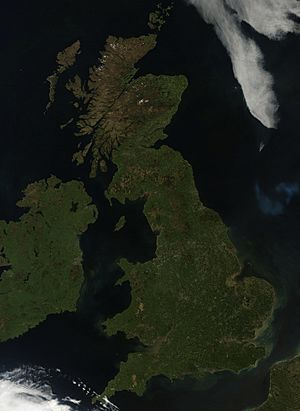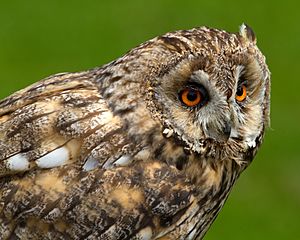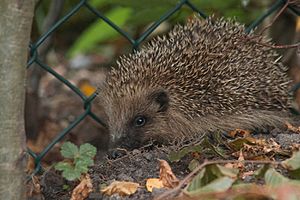Fauna of Great Britain facts for kids
The island of Great Britain is part of the British Isles. It has a mostly mild climate. This means it doesn't have extreme hot or cold weather. Great Britain has a smaller amount of wildlife compared to other places. Many animals disappeared during the last ice age. After the ice age, Great Britain became separated from Europe by the English Channel.
Since then, people hunted some large animals to extinction. These include the wolf, the brown bear, and the wild boar. However, animals like dogs and pigs, which are related to these wild animals, still live here. The wild boar has even been brought back to be raised for meat.
Contents
Great Britain's Climate and Wildlife
Most of Great Britain has a mild climate. It gets a lot of rain and a medium amount of sunshine. As you go further north, it gets colder. Here, you'll find coniferous forests with trees like pines. In the south, there are more deciduous forests, where trees lose their leaves in autumn.
There are a few different climates in Britain. Some areas, like the Scottish Highlands, can be very cold, almost subarctic. Other places, like the Isles of Scilly, can be quite warm, almost sub-tropical. Plants in Britain must handle changes in sunlight, rain, and temperature throughout the year. They also need to survive snow and frost in winter.
Since the 1700s, Great Britain has changed a lot. There has been a lot of industrialisation (building factories) and urbanisation (cities growing). A study from 2006 showed that about 100 species of animals became extinct in the UK during the 1900s. This is much faster than normal. These changes have greatly affected native animals. For example, songbirds are becoming less common. Losing their homes has also hurt larger mammalian species.
However, some animals have learned to live in cities. The red fox is very good at this. It's the most successful wild animal in cities after the brown rat. Other creatures, like the common wood pigeon, also do well in urban areas.
Invertebrates
Invertebrates are animals without a backbone. This group includes insects, spiders, and snails.
Molluscs
There are 220 types of snails and slugs that live in the wild in Britain. Two of these, Fruticicola fruticum and Cernuella neglecta, are now extinct in Britain. There are also 14 types of snails that only live in greenhouses.
Insects
Britain is home to many different kinds of insects.
Vertebrates
Vertebrates are animals with a backbone. This group includes amphibians, reptiles, birds, mammals, and fish.
Amphibians
Amphibians are animals that can live both on land and in water. The native amphibians in Britain are:
- The great crested newt
- The smooth newt
- The palmate newt
- The common toad
- The natterjack toad
- The common frog
- The pool frog
Some other amphibian species have also settled in Britain.
Reptiles
Great Britain has only a few types of snakes. The European adder is the only venomous (poisonous) snake found here. Other snakes include the barred grass snake and the smooth snake.
Britain has three native types of lizards:
You can also find turtles, like leatherback turtles, in the Irish Sea. However, these are rarely seen. Some other reptile species live in Britain but are not native. These include the aesculapian snake and the wall lizard.
Birds
The birds of Britain are similar to those found in Europe. Most are Palaearctic species, meaning they come from a large area including Europe and Asia. Because Britain is an island, it has fewer types of birds that breed there compared to mainland Europe. Some birds, like the crested lark, breed very close by in northern France but haven't settled in Britain.
Britain's mild winters mean that many birds from Europe come to spend the colder months here. About 250 bird species are regularly seen in Great Britain. Another 350 species visit less often.
Mammals
There aren't many large mammals living wild in Great Britain today. Many large species, like the grey wolf and the brown bear, were hunted until they became extinct centuries ago. However, some of these large mammals have recently been brought back to certain areas of Britain.
The largest wild mammals still in Britain are mostly from the deer family. The red deer is the biggest native mammal. It is common across England, Scotland, and Wales. The roe deer is another native species. The common fallow deer was brought to Britain from France by the Normans around the 11th century. It has now become very common. The sika deer, originally from Japan, is another type of deer that is not native. It is spreading in Scotland and can also be found in parts of England.
Britain also has several types of insectivores. These are small mammals that eat insects. The European hedgehog is probably the most well-known. It often visits gardens in towns and cities. The European mole is also common. Its tunnels under the ground can damage lawns. Shrews are also quite common. The smallest, the Eurasian pygmy shrew, is one of the smallest mammals in the world. There are also seventeen types of bats in Britain. The pipistrelle is the smallest and most common bat.
Rodents are also very common across Britain. The brown rat is the most common wild mammal in cities after humans. However, some rodents are becoming rare. Losing their homes has caused a drop in the number of dormice and bank voles. The red squirrel has mostly disappeared from England and Wales. This is because of the grey squirrel which was brought over from North America. The last red squirrel groups are in parts of North West England and on the Isle of Wight. European rabbits and European hares were brought to Britain by the Romans. The native mountain hare now only lives in Scotland and a small group in Derbyshire.
Eurasian beavers used to live in Britain but died out by the early 1500s due to hunting. Now, people are working to bring beavers back.
Britain has various carnivores, which are meat-eating animals. Many are from the weasel family. These include the small weasel, stoat, and European polecat. Larger members are the European badger, pine marten, and the otter, which lives near water. The mink was recently introduced.
Since the grey wolf and brown bear are no longer here, the largest carnivores are the badger and the red fox. The fox is very adaptable and lives well in cities. The European wildcat is very shy and hard to find. It is thought to be highly endangered, partly because it can breed with domestic cats.
Different types of seals and dolphins can be seen seasonally along British shores. Harbour porpoises, orcas (killer whales), and many other sea mammals also visit.
Fish
Great Britain has about forty types of native freshwater fish. The largest of these is the salmon. Saltwater fish include larger species like sharks, found in the seas around Britain.
Animals That Are No Longer Here
During a warmer period called the Eemian Interglacial (about 130,000 to 115,000 years ago), Britain's climate was similar to or slightly warmer than today. At that time, Britain had many more types of large mammals.
Large plant-eating animals present then, but not now, included:
- The large straight-tusked elephant
- The narrow-nosed rhinoceros
- The hippopotamus
- The Irish elk
- The bison
These were in addition to the red, fallow, and roe deer that are still here.
Large meat-eating animals from that time included hyenas (Crocuta spelaea) and lions (Panthera spelaea), as well as wolves and brown bears.
Later, during the Holocene (our current geological period), other animals lived in Britain but are now extinct. The aurochs, which was the wild ancestor of modern cows, lived here until about 3,500 years ago. The Eurasian lynx was also native to Britain. The last records of it are from about 1,500 years ago. The moose was present in Britain in the early Holocene but died out around 5,600 years ago. The European pond turtle also lived in Britain during the Holocene, with the most recent records from about 5,500 years ago.
See also
 In Spanish: Fauna de Gran Bretaña para niños
In Spanish: Fauna de Gran Bretaña para niños




